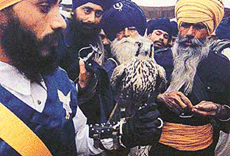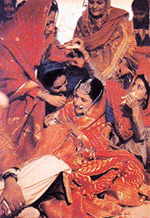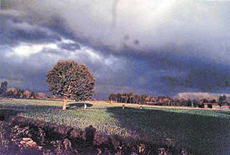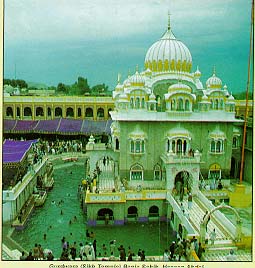| |
|

Nihangs admiring a
hawk
|
The Sikh’s favourite profession
is farming; over 80 per cent of the community live off the soil. And next
to farming, soldiering; at one time almost a quarter of the British Indian
Army were Sikhs; even today one out of every ten Indians in uniform is a
Sikh.
The Sikhs have a lot in common
with the Jews: indeed most Sikh patriarchs look like Jewish rabbis.
Both the Jews and the Sikhs have known persecution; the Jews for
nearly 2,000 years at the hands of the Christians and Muslims; the Sikhs
for about 200 years at the hands of the Muslim conquerors and rulers of
northern India. It never got them down. Like the Jews, the Sikhs regard
themselves as the chosen people. A well-known Sikh historian wrote: ‘Where
there is one Sikh there is one Sikh; where there are two Sikhs, there is
an assembly of saints; where there are five Sikhs, there is
God.’
Not many people share the
Sikhs’ self-esteem. On the contrary, they regard them as slow-witted and
aggressive, rustic types, good only to be used as cannon-fodder. ‘The only
culture the Sikhs know is agriculture,’ they say. There is some truth in
these back-handed compliments. The Sikhs do happen to be India’s best
farmers. They, more than any other people, have brought the Green
Revolution to India by trebling the wheat yield of the acre and are
definitely the most prosperous peasantry of India. In a country teeming
with beggars, it is rare to see a Sikh stretch out his hands for alms.
Their aggressiveness is born out of an innate sense of one-upmanship —
anything anyone else can do, the Sikh can do better. Three of the nine
Indians who scaled Mount Everest were Sikhs; more than a third of all
India’s athletic teams are usually Sikhs. A clue to what makes the Sikh
ethos can be found in their religion and history.
The Sikh Way of
Life
Nine out of every ten Sikhs
live in villages and hamlets, most of them in comfortable homes with
expansive courtyards where their cattle are tethered. Families of sons of
the same father live under one roof till their land is divided. Almost
every Sikh home today has a transistor radio and a fair proportion own
television sets as well. The more prosperous amongst them own their
tractors and tubewells.

A bride being blessed after
Anandkaraj |
A Sikh village invariably has a
gurdwara which can be recognised from a distance, because of its tall
flagpole draped in yellow and the triangular flag bearing the Sikh emblem
consisting of a quoit with a double-edged dagger in the centre and two
crossed swords beneath.
Sikh peasants are great eaters.
Although not vegetarian, they seldom manage to eat meat except on
occasions like weddings. Then their preference is for goat meat which they
honour with the name mahaprasad — the great offering. The Sikhs’
staple diet consists of wheat, buffalo milk and milk products like curd,
buttermilk and clarified butter (ghee). During the winter months their
favourite food is mustard leaf mash (sarson ka saag) capped with
blobs of fresh home-made butter eaten with whole meal bread of chickpeas
(makkai ki roti) or millet (baajra). All this is washed down
with gallons of buttermilk. This diet is both wholesome and nourishment
and explains the Sikhs’ excellent physique, vitality and stamina. An
English dietician, who experimented with diets of different Indian
communities by feeding rats on the food eaten by Pathans, Rajputs,
Marathas and Gurkhas, found that the ‘Sikh rat’ was healthier than the
rats of other martial communities.
What is in a Sikh
name
Every male Sikh bears the name
Singh, as does every female Sikh the name Kaur. However, although all
Sikhs are Singhs or Kaurs, all Singhs and Kaurs are not Sikhs. The word
Singh means a lion; its female counterpart Kaur means both princess and
lioness. Both were common amongst Hindus, notably in the martial classes
like the Rajputs, Jats and Gurkhas, long before Guru Gobind Singh made
them obligatory for his followers. In doing so the Guru had two
objectives. In India, one way of telling a person’s caste is by his name.
In making all Sikhs Singhs (and Kaurs) he made them into one casteless
fraternity. In choosing Singh and Kaur, he also emphasised martial traits
which he hoped to infuse in them.
Although the vast majority of
Sikhs abide by the Guru’s ordinance and are content to remain plain and
simple Singhs, a growing number now attach their caste or village names to
themselves. Thus those belonging to Guru Nanak’s caste describe themselves
as Bedis, e.g. the cricketer Bishen Singh Bedi. Those belonging to the
caste of the last six Gurus add Sodhi to theirs, e.g. Kartar Sodhi. As a
consequence, most Hindu caste names can be found amongst Sikhs, e.g.
Justice M.S. Joshi (Brahmin), Comrade (Communist leader) Avtar Singh
Malhotra (Kshatriya), General Jagjit Singh Aurora (Vaishya). The lower
castes often take on surnames of higher castes, Jat tribal names like
Randhawa, Gill, Grewal, Sandhu and Siddhu are commonly used. Equally
common is to add the name of the village, e.g. Harchand Singh Longowal,
Gurcharan Singh Tohra, Parkash Singh Badal. Sikh poets often follow the
convention common among Urdu poets and add their pseudonyms to their names
, e.g.Pritam Singh Safeer (envoy). Sometimes the combination of
names can be quite incongruous, e.g. Gopal Singh Dardi, which
literally translated, would mean cow-protector-lion who feels the anguish
of others.
|

Mustard fields of
Punjab
|
Love for martial traditions is
reflected in Sikh names like Laftain (Lieutenant), Kaptaan (Captain),
Major and Jarnail (General). A child born in his maternal grandfather’s
house (naankey) as was Guru Nanak, may be named Nanak Singh, the
girl Nanki. One born on Basant Panchmi, may be a Basant Singh or
Basant Kaur. Nihang Sikhs often give themselves wishful names. During
Mughal rule a favourite name was Dil Tor Singh (the lion who will destroy
Delhi); during British rule, London Tor Singh, Amongst the peasantry, if
the child is fair, he may be named Angrez (English) Singh or Angrez Kaur
or just Bugga (white) Singh. Then there are names that are not found among
city dwellers but can be found among peasants, e.g. Shanghara, Jhimma,
Balakara.

Shri Panja Sahib, Historical Gurdwara |
Sikh names, like their faith,
derive both from Hindu and Muslim sources. Names like Iqbal, Nawab, Qurban
and Mubarak are Persian and of Muslim ancestry. However, the majority are
of Hindu-Sanskrit lineage. e.g. Ranjit, Surjit, Baljit (victors of
battle); Jagdeep (giver of light); Baldev (good of war); . Even English names have come into vogue
amongst aristocratic families, e.g. Peter, Billy, David, Cecil (the House
of Patiala); Anne, Pearl, Honey (the House of Jind).
The fact that most Sikhs are
Singhs and there are not too many first names to choose from does not
cause as much confusion as one might imagine. Quite often descriptive
appendages are coined to distinguished incumbents of the same name.Thus
two Kartar Singhs living in the same locality may be distinguished from
each other as Kartar Singh Dhiddal (the pot-bellied) and Kartar
Singh Ainkee (one who wears glasses).
Any name is grist to the
Sikh-naming mill. A well-meaning but somewhat anglicised father in Delhi
is said to have named his four sons Gentle Singh, Humble Singh, Noble
Singh and Simple Singh.
It is the immortality of sacred identification with Sri Guru
Gobind Singh Sahib, the immortality of a mystical union with Sri Guru Gobind
Singh Sahib, and the immortality of total reliance in the Divine Name that
distinguishes and marks the Khalsa from others.
The best of
all Religions is the yearning for the Divine and purity of deeds.
Excerpted from The Sikhs, by Khushwant Singh published by
Lustree Press/Roli Books
|

